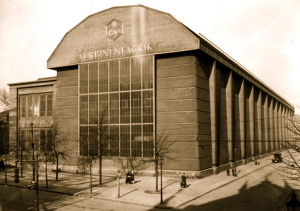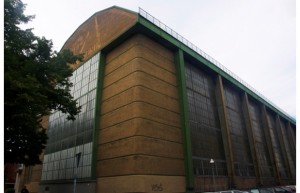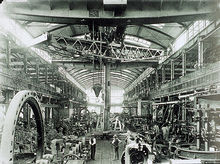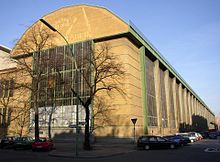#27. AEG Turbine Factory

AEG: A Brand Makes History
It was Thomas Edison who, in 1879, with the design of the light bulb, doused the world into electric light and had this innovation patented. The triumphal advance of electric lighting began. Endowed with the rights to use Edison’s invention, Rathenau had already, a year earlier, in 1883, founded the “Deutsche Edison Gesellschaft für angewandte Electricität” (German Edison Company for applied electricity). In 1887, it is being renamed “Allgemeine Electricitätsgesellschaft “. The AEG is born, headed by Emil Rathenau. In 1891, at Halle an der Saale, the company built a complete electric streetcar system. It is the first of its kind in Europe and an economic success. Only five years later, 34 trams are in operation or under construction. At this time, the long-time chief engineer at AEG, Mikhail Dolivo-Dobrowolsky is already considered “the father of AC technology.” He devoloped the three-phase alternating current. First he invented the so-called “squirrel cage induction motor”, then the three-legged three-phase transformer. With this, phase electricity becomes practically useful. To date, the induction motor is the most widely used electric motor. Without transformers there is no power transmission. On the occasion of the International Electro-technical Exhibition in Frankfurt am Main, also in 1891, the AEG again sets new standards. They build the first long distance transmission of electricity: by means of the new transformers, high voltage three-phase current of 20,000 volts would be transmitted over 176 km, from Lauffen to Frankfurt am Main . The AEG is able to demonstrate that electricity can be transported with low conduction losses over long distances. A regional setup of power plants has become possible. Nationwide supply of electricity in the German Reich is fast approaching.
1899: At the Berlin-Spandau Canal, the power plant Moabit goes into operation. It supplies current to a voltage of 6 kV, which enables it to provide for a larger area. The power generation business has become an integral pillar of the AEG. Two years slater, at the turn of the century, the corporate group has set up around 248 power plants at home and abroad, with a total capacity of nearly 200,000 KW in Germany and abroad. Top performance also on the track: In 1903, this three- phase express railcar achieved a world record, with a speed of 210.2 kilometers per hour. In 1911, the first electrified mainline railway line in Germany, between Bitterfeld and Dessau, is put into operation. With the outbreak of World War I, the management structure of the AEG changes. In 1915, Emil Rathenau dies. The leadership of the AEG is now in the hands of his son, Walter Rathenau. During war he focuses on the armament factory, compensating for the drop of overseas market orders. After World War I, the German economy is suffering from the reparations to the Allies. But in 1922, with the Treaty of Rapallo, between Germany and Russia, The German Reich is able to liberate itself from the isolation. The treaty had been negotiated by Walther Rathenau, who, meanwhile, had become Foreign minister. The AEG takes considerable benefit. Russia is now its largest trading partner.
Berlin in the 1920s: The Roaring Twenties bring an impressive economic recovery for the Weimar Republic, especially the electrical industry. In 1923, the Vox-Haus in Berlin 1923 hosts the first German radio station. Via the TELEFUNKEN-company, AEG is directly involved. Starting in 1924, the same is true with the development of new, young medium called “television”. From 1928 on, the first TV sets of TELEFUNKEN are on the market. With the 1936 Berlin Olympic Games, the big moment of television has come. The mighty Ikonoskop, developed by AEG Telefunken, is the first mobile television camera in the world and is popularly called “the Olympic cannon”. It provides most of the competition photos in the Olympic Stadium … amongst others to 25 connected public TV households in Berlin. Meanwhile, the construction and development of proven and tested AEG technologies AEG goes ahead with giant strides. At the Internationale Funkausstellung of 1967, with a symbolic push by Germanys Foreign Minister Willy Brandt, the familiar black and white television picture takes on color. The Telefunken PAL system: An innovation of TELEFUNKEN. In 1970, after the merger with TELEFUNKEN in the same year, the AEG is the twelfth-largest electric company in the world, with about 180,000 employees. The products of AEG-Telefunken are labelled with the seal of quality: “Made in Germany.” Now, the close trade relations with Moscow that exist since the days of Walther Rathenau pay off. Until the year 1984, AEG delivers 240 powerful gas turbine and compressor stations to the Soviet Union.
 AEG Turbine Factory Location: Berlin, Germany Architect: Peter Behrens Year: 1908/9
AEG Turbine Factory Location: Berlin, Germany Architect: Peter Behrens Year: 1908/9
Behrens’ great legacy in design is his effort to bring dignity to the workplace. The AEG Turbine Factory is the crowing achievement in that quest, a building of glass and steel with a monumental facade. Within, Behrens’ clean, moderate rooms greatly impressed the famous Swiss architect Le Corbusier.
 Shape and height of the building axis are given by the three joint ties.
Shape and height of the building axis are given by the three joint ties.
The AEG turbine factory was built around 1909, in the Berlin district of Moabit, the best known work of architect Peter Behrens. It is an influential and well-known example of industrial architecture. Its revolutionary design features 100m long and 15m tall glass and Steel walls on either sides. A bold move and world first that would have a durable impact on Architecture as a whole.
Origin
Inner view of the Fabrc, 1900
The site was since 1892, occupied by the electrical company founded by August Thyssen and the Thomson Houston Electric Company, the Union-Elektricitäts-Gesellschaft (UEG). The company’s goal was to get into the booming electrical industry, and this site was dedicated to the production of electrical Trams. But the company quickly encountered financial difficulties, and the Allgemeine Elektricitäts-Gesellschaft (AEG) took over in 1904 and planned the construction of a new turbine factory, as the existing factory had become too small.
The architect Peter Behrens was commissioned with the construction of the new building. More than an architect, Behrens was employed from 1907 by AEG as an artistic consultant and designed the company logo, and other company graphics for the building. He was also in charge of the overall image of the company. Initially influenced by the developing Art Nouveau , the architect turned soon to the Werkbund, which in turn was influenced by the British Arts and Crafts.
Construction
 Plaque on the AEG-Turbinenfabrik
Plaque on the AEG-Turbinenfabrik
The turbine hall was built in 1909 under Peter Behrens as lead architect and engineer Karl Bernhard at the angle of the Huttenstraße (12-16) with the Berlichingenstraße streets in Berlin-Moabit. The original building measures 25.6 m + 12.5 m in width, a height of 25 m and a length of 123 m. Behrens’ design provided a neo-classical look to the industrial building, with weighty (but non-functional) gable ends and trabeated ‘columns’ to either side. David Watkin describes it as a “temple of power.”
In 1939, Jacob Schallberger and Paul Schmidt designed an extension of the hall to the north. The whole building has been developed to function as a production site for turbines. It is now part of Siemens, which still operates a gas turbine plant there. This factory was actually designed with such foresight, that it still serves the same purpose of producing turbines, a hundred years later.
Shape and height of the building axis are given by the three joint ties.
The other factories that AEG had at that time, mostly known as “crenellated castle-cities” were places where technology occurred in a dowdy coat of historicist design. Among the requirements and expectations of the AEG was the intent to design an impressive and sophisticated, large scale construction. Peter Behrens created an architecture for the industry that came out of the clamp of hiding behind historic facades and transformed itself into a new self-confidence.
The building is classified since 1956, and underwent a restoration in 1978. On the south side there is a plaque with information about the construction, architects, and heritage status.



